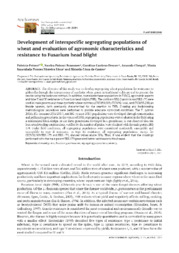Development of interspecific segregating populations of wheat and evaluation of agronomic characteristics and resistance to Fusarium head blight.
Development of interspecific segregating populations of wheat and evaluation of agronomic characteristics and resistance to Fusarium head blight.
Author(s): FRIZON, P.; BRAMMER, S. P.; DEUNER, C. C.; CHECHI, A.; LIMA, M. I. P. M.; CASTRO, R. L. de
Summary: Abstract: The objective of this study was to develop segregating wheat populations for resistance to gibberella through the introgression of synthetic wheat genes in traditional cultivars and to present the results using the backcross method. In addition, to evaluate these populations in F1RC2, agronomic aspects and type II and III resistance to Fusarium head blight (FHB). The cultivars BRS Guamirim and BRS 179 were used as male parents and three synthetic wheat cultivars (CIGM90.909, CIGM92.1666, and CIGM93.298) as female parents, both previously characterized for the reaction to FHB. Crossing and backcrossing methodological procedures were performed to provide adequate controlled conditions. The F1 (winter 2016), RC1 (summer 2016/2017), and RC2 (winter 2017) populations were developed through emasculation and pollination procedures. In the winter of 2018, segregating populations were evaluated in the field using a randomized block design. In the three generations developed in a greenhouse, it was observed that the best crossbreeding combinations, verified by the number of grains, were obtained with the male parent BRS 179. Under field conditions, all segregating populations were considered moderately susceptible and susceptible to type II resistance. In type III resistance, all segregating populations, except for CIGM90.909/BRS 179 and BRS 179, showed values above 50%. Thus, it was evident that the crossings performed with the male parent BRS 179 generated better resistance to the disease.
Publication year: 2023
Types of publication: Journal article
Unit: Embrapa Wheat
Observation
Some of Embrapa's publications are published as ePub files. To read them, use or download one of the following free software options to your computer or mobile device. Android: Google Play Books; IOS: iBooks; Windows and Linux: Calibre.
Access other publications
Access the Agricultural Research Database (BDPA) to consult Embrapa's full library collection and records.
Visit Embrapa Bookstore to purchase books and other publications sold by Embrapa.

